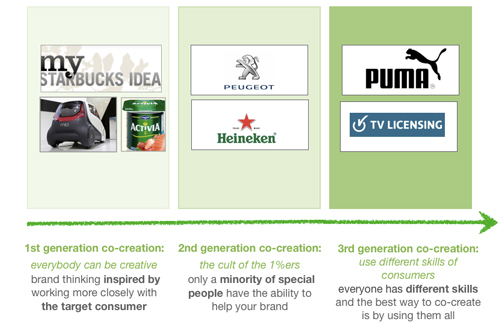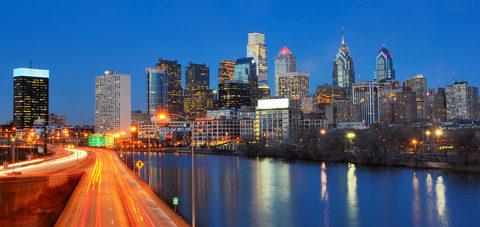Anna Peters
10 years ago hardly anyone had heard of it, but now it is de rigueur to invest huge amounts in running big innovation programs in this methodology. It has even become a profession in its own right.
So where did co-creation come from, and where is it going?
1st generation co-creation: “everybody can be creative”
Back in the early 2000s the first co-creation agencies came into being – based upon the groundbreaking article by C.K. Prahalad and Venkat Ramaswamy in the Harvad Business Review, Co-opting Customer Competence, and further built on in their book The Future of Competition, Co-Creating Unique Value With Customers. These new agencies operated on two assumptions:
- Consumers want to be involved with brands
- Everybody can be creative
Drawing from the psychoanalytic tradition, co-creation 1.0 threw the stiff formalities of traditional market research out of the window and used more fluid and iterative techniques to connect with willing consumers to develop creative solutions for brands. mystarbucksidea.com is a good example of co-creation 1.0 – a hugely successful platform which invites everybody to become involved with developing product and brand solutions.
Criticisms of co-creation 1.0: Co-creation 1.0 has it’s limitations – and critics argue that the assumptions that, everybody wants to be involved with brands and everybody can be creative are challenging. Indeed, organisations which operate with the 1.0 model of co-creation often face huge amounts of ‘wasted potential’ – of a 300 person online community only 50 members would be truly active, and of those an even smaller proportion are developing great ideas.
2nd generation co-creation: “the rise of the 1%ers”
Co-creation 2.0 was born from a backlash of this wasted potential, and so began the rise of the 1%ers. Co-creation 2.0 is based upon the belief that only a tiny proportion of the population have the ability to be co-creative, and it is only this very small proportion of population that organisations operating on the 2.0 model of co-creation ever engage with.
The 1%ers help brands to innovate because they bring switched on, smart and articulate people together as an extension of the marketing team – and brands such as Heineken have tapped into a ready and willing pool of creative sorts to define some truly impressive ideas.
Criticisms of co-creation 2.0: Engaging the 1%ers in sexy brands or groundbreaking challenges is easy – these creatives are turned on by the idea of defining a big solution for big brands. But what about brands that aren’t so sexy? These brands may face challenges when it comes to co-creation 2.0 because they just don’t have the ability to capture the hearts and minds of the 1%ers – meaning the return that they get from their explorations into co-creation don’t return as much as promised.
Co-creation 3.0: “the future of co-creation lies in using skilled consumers at the right point in the process”
Co-creation 3.0 uses skilled consumers at the right point in the co-creative process, and offers a compromise between the extreme positions ‘everyone can be creative’ + ‘only 1% of people can be creative.’
Benefits of co-creation 3.0: The benefits are clear for brands and consumers alike: by identifying the specific skills of co-creators (for example, critical thinking, creativity, connectedness, curiosity, etc) at the beginning of the process, we can make the most of their abilities throughout the process. This helps get better results in 2 ways:
Less wasted potential
Knowing how best to use every co-creators skill set means that consumers are only engaged in tasks that they have and in interest in, and in which they are able to make valuable contributions.
For consumers this means more by way of intrinsic reward – it’s more fun and they can see that they are having a greater impact on the brands they care about.
For brands this means less ‘wasted potential’ – in other words there is less money spent on recruiting and rewarding co-creators that aren’t actually adding much to the end result.
More than just creativity
Using skilled consumers to look at the brand challenge means that we’re being truly co-creative: ‘creatives’ are just one type of person … and co-creation is about difference and cross- fertilisation of ideas, so it’s important to make the most of the multiple word views available to us.
For consumers this means that they are engaged in process that encourages cross-fertilisation of ideas. For brands this means that the resulting ideas are ultimately more divergent. So, is the future of co-creation filled with skilled consumers?
I think so.
The benefits to brands in terms of less wasted potential are huge, because every brand owner wants to be getting the biggest bang for his buck.
The benefits for consumers are also big, because it’s a much more fruitful and enjoyable to have your skills recognised and be asked to use them in a way that makes a real difference.
Anna Peters is Director of Co-Creation, Bright Young Minds




8 comments
Cocreation is hot and sexy. But not all that glitters is gold. I have 4 questions: at a DEEPER level, how is it different to regular qualitative research? Does it lead to BETTER outcomes? If so HOW does it achieve these/through which mechanism? What does it believe ordinary people are capable of?
Let me have a crack at answering your questions.
Q: How is it different to normal qual?
A: Regular qual tries to counter bias, co-creation embraces & makes the most of bias: normal qual is based on the principles of research, and this means that we put participants into various unnatural situations – and of course this leads to various biases. The research solution is to acknowledge these biases but the co-creative approach goes one step further and actually uses this bias to develop deeper insights (…it’s all based on principles of gestalt psychology & group therapy and I have written a more in-depth article on it here – /2012/03/07/my-bias-is-bigger-than-your-bias/ )
Q: Does it lead to better outcomes?
A: yes, and it does this in 2 ways: Firstly, it leads to better insight & ideas – in one project for a large FMCG company we tested (via standardised quant methodology) the co-created insights against insights developed in the traditional way. The co-created insights performed 82% better. Secondly, it makes the process much more fun and interesting for the clients – Jonathan Gadd (VP@Publicis) said the co-creative approach not only created better insights and ideas, but it was also “refreshing.” And it’s this ‘refreshment’ that leads to greater organisational buy-in, and ultimately more commitment to the final execution of these insights & ideas.
Q: How does it do this?
A: It does this by democratising the process; brands and services aren’t owned by brand managers or CEOs – they are owned by the people that use them! With this in mind, it is crazy to use a paradigm (i.e. the traditional research paradigm) that doesn’t allow so-called ‘ordinary people’ to have a fair say in the future of THEIR products and services.
Q: what does it believe ordinary people are capable of?
A: Co-creation believes ALL people [nb: I am not using the term ‘ordinary people’] are capable of affecting real and visible change. There are various schools of thought here (as discussed in the article: 1st gen co-creation versus 2nd generation co-creation, versus 3rd gen co-creation) and I’m a proponent of 3rd generation, i.e. the belief that different people have different skills and that you see powerful change when you acknowledge this difference. It’s important to allow all people to shine at what they are good at…and I agree with Jeff in his above comment to this article: “I place responsibility on the facilitators of co-creation”
Co-creation is becoming more valuable as people are using skype and cloud-computing techniques to share project ideas. It is a godsend for analysts, reporters and others who may be short on expertise in certain areas. Co-creation is a tool I believe we will see more of in the months to come. Great article!
Nice summary of the evolution of co-creation. However, I would argue that it’s not just about a “brand challenge” as stated at the end of the article. Co-creation can be used to solve wider business problems and also assist in shaping the future offer by identifying current problems that consumers have with products and services. Co-creation, whether applied in creative workshop sessions or in online communities, is often just one stage of a bigger project that starts with the problem identification and an insights exploration. Once the problem/challenge is stated you can move into the co-creation stage. If you have a good and honest relationship with your client you should always be able to ask them about the purpose of the project and the background to the stated challenge. By defining the real problem and writing a creative brief that your “skilled consumers” understand, you have set the foundation for a successful co-creation process. Even if you (addressing all clients here) think that consumers are not really engaged with your brand and that co-creation is not for you, I can tell you from experience that when your agency sets up an engaging process and recruits skilled creative consumers, you can even create great new ideas for less exciting products like nasal sprays.
Robert Homberger, TLE (The Leading Edge) Sydney
Hi Robert, thanks for your comment – and actually you are completely right…co-creation shouldn’t just be limited to brand challenges. Currently that is where it is most prevalent – but the applications go far beyond that.
i’m note sure if you can think of any more examples, but a few off the top of my head are:
1. redesigning & reshaping the way that the public interact in their local communities. And a really great example of this in action is something that a friend & co-creator Tom Hoy has been doing at Lambeth council
(here’s a little summary of Tom + Lambeth council’s work: http://brightyoungminds.net/news-article/lambeths-own-co-creation/)
2. The other way that will be really exciting for co-creation to be used is structurally in organisations. I get the sense that employees are getting a little jaded with the 9-5 and the typical career trajectory. And I see amongst my peers a strong movement to networked careers and a preference for organisations that are structured very differently from today. I think that in the future we’ll see organisations using co-creation as a way out of the silos that exist the manufacturing based monday – friday, clock-in and clock out model.
(I wrote something a little while ago around this topic, not exactly related but it might spark a few ideas with you…./2012/01/26/from-insight-to-foresight-in-2012/)
So thanks again for raising your point – I agree with you that the applications of co-creation (beyond brand and product innovations) is a fascinating topic: if we can apply the co-creative approach the way that we do business and the way that organisations are structured then just imagine the possibilities.
The world could look incredibly different….
Appreciate this topic – it’s a line of inquiry that needs to be better understood. And it’s a question I struggle with today.
We all have what could be called ‘latent creativity.’ An over emphasis on rational thinking and logic has limited our spontaneity and resourcefulness. Most of us have developed habits of mind that prevent creative thinking.
This ‘wasted potential’ is a fair assessment – I’ve seen it happen too many times. That said, I place responsibility on the facilitators of co-creation. It is their role to create the spaces, experiences and dialogue that can provide people who may not know their creative ‘skill’ the ability to contribute significant value.
Using expressive arts techniques (e.g. role play, word play) is one way to tap into the creativity that lies within us all. Perhaps we will find better ways to learn from the individual and collective genius.
And no more wasted potential!
Yes Jeff! facilitation is absolutely key and understanding who has what skills can never compensate for poor facilitation skills.
For me it’s a case of applying strong facilitation of all those brilliant techniques you mention (expressive arts, etc) to unlock skills, then IN CONJUNCTION with understanding when in the process to use those skills you’ve unlocked.
I’ll give you an example:
A creative consumer is brilliant at coming up with divergent ideas, and really pushing brands to think differently about their product.
However, when it comes to how exactly the brand should execute this innovation, the creative thinker may not be best placed to help in this process.
Instead a consumer who has a critical eye and isn’t afraid to challenge and build on other people’s ideas may be better placed at this point in the process.
So: YES to strong facilitation to unlock consumer’s different skill sets, BUT to make the strong facilitation even more powerful we facilitators also need to know how and when to apply these different skill sets to the process of co-creation.
For a timeline of all the crowdsourcing projects since the beginning of time (well, since 2006) check this out:
http://www.tiki-toki.com/timeline/entry/52997/Crowdsourcing-by-Worlds-Best-Global-Brands/#vars!date=2013-06-30_22:16:10!
An interesting commentary that demonstrates how the cult of the 1%ers came into existence in the mid-2000s, and has been growing steadily ever since.
…It would be interesting to overlay co-creation 1.0 and 3.0 onto this timeline to see if how my analysis in this blog post
plays out.
Anna